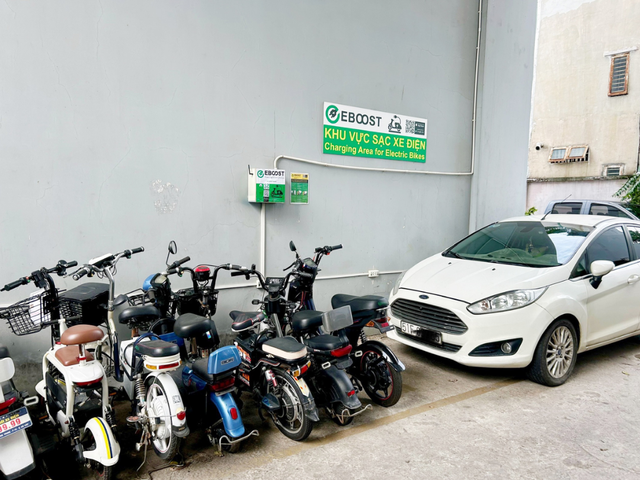
Residents are introduced to electric scooters at a showroom on To Ngoc Van Street in Ho Chi Minh City. Photo: Thanh Hiep / Tuoi Tre
A survey conducted on Tuesday morning by Tuoi Tre (Youth) newspaper reporters in downtown Ho Chi Minh City and in some residential areas revealed that EV charging stations for electric cars and motorbikes are scarce.
The reporters found it hard to see a charging station at some parks near such busy streets as Nguyen Thi Minh Khai, Le Duan, and Dinh Tien Hoang.
In many apartment buildings citywide, such as one in Long Truong Ward, the majority of residents still rely on gasoline-powered vehicles.
Not only are dedicated parking spots for EVs absent, but no charging points exist either.
At another building in Binh Thanh Ward, the situation is even more constrained, with residents often forced to park their vehicles on surrounding streets due to a lack of parking space, let alone charging facilities.
Ngoc Anh, a dweller of the apartment building, lamented the absence of support for EV users.
“Electric motorbikes are parked alongside gasoline ones but are not allowed to charge on-site. I spent a day looking around for public charging stations in my neighborhood, but found none,” she said.
Hoang Tuan, who resides in an apartment building in Khanh Hoi Ward, expressed a desire to switch to an EV, but emphasized the need to invest in charging infrastructure to accommodate a large number of electric cars and motorcycles.
Residents will surely support the shift to EVs if access to a charging station is easy, he said.
He also wondered where 400,000 delivery and ride-hailing drivers would charge their EVs if they switch to these vehicles.
Ho Chi Minh City has set a phased target to transition 400,000 gasoline-powered motorbikes to electric ones, focusing first on delivery workers and ride-hailing drivers.
On average, each of these drivers travels 80 to 120 kilometers per day, three to four times more than the average distance of a resident, making them a priority group for the initial phase of the transition.
As a result, the image of delivery and ride-hailing drivers traveling frequently on clean, quiet electric vehicles is expected to help shift public perception and drive demand for electric motorbikes.
Nguyen Tan Luc, a ride-hailing driver, shared that he supports the green transition but was wary of the practical barriers.
“Electric motorbikes are still inconvenient. If I run out of battery mid-route, finding a swap station is a nightmare. Gasoline still wins for now,” he said.
Le Thanh Hai, director of the Center of Consultancy Information Training on Economic and Business Management under the Ho Chi Minh City Institute for Development Studies (HIDS), said that the city suffers a charging infrastructure gap.
According to data from HIDS, the city currently offers only 600 public EV charging points, meeting just 10 percent of the demand of a projected fleet of 350,000–400,000 electric motorbikes.
In response, a bold proposal aims to increase that number to 3,000 public charging and battery-swapping stations by 2028, five times higher than the current count.
In Hanoi, V-Green Global Charging Station Development Company (V-Green) has installed 1,000 charging stations, including public fast-charging stations and personal chargers.
However, the lack of a unified national standard has resulted in a fragmented charging landscape.
To address this, the municipal Department of Construction worked with major players including TMT Motors, V-Green, EVG Group JSC, and Vingroup to find solutions.
These firms proposed shared-use charging stations and recommended converting public locations like shopping centers, bus stations, and parks into charging zones.
HIDS suggested a layered infrastructure strategy: high-speed 60kW chargers at logistics stops, ultra-fast battery-swap stations at delivery hubs, and 3.3kW slow chargers at apartment buildings for overnight charging.
The charging model could meet 98 percent of EV users' charging needs by 2028.
Charging stations should be everywhere
Public land should be utilized for charging infrastructure.
Proposals include setting up chargers at petrol stations, the headquarters of local authorities, parks, supermarkets, wet markets, and shopping malls.
HIDS has urged grassroots authorities to publish a list of eligible public locations and offer preferential or rent-free access for the first few years.
Relevant units should also address issues related to the power grid and potential overloads, which need to be considered as the transition from gasoline to electric vehicles increases electricity demand.
Furthermore, new housing and commercial center projects should be required to allocate at least 35 percent of parking areas for EVs, with integrated chargers.
Investors who comply would benefit from land-use fee reductions of up to 50 percent.
Hanoi is drawing up a master plan to expand EV charging networks in high-traffic and densely populated areas, with measures including pilot projects, simplified processes for licensing charging station development, and technical standards tailored to Vietnam’s diverse vehicle mix.
Nguyen Huu Phuoc Nguyen, CEO of electric vehicle start-up Selex Motors, stressed the importance of adopting international charging standards.
“Vietnam should look to models in Japan, Europe, and North America. Having one or two unified standards would make EV adoption much more seamless for consumers,” he said.
Echoing the view, Dr. Nguyen Phuc Khai from the Ho Chi Minh City University of Technology emphasized the need for charging standards.
He also suggested improving electrical infrastructure and offering subsidized electricity rates for EV charging.

Bikes are charged at a corner of an apartment building in Ho Chi Minh City. Photo: T.T.D. / Tuoi Tre
Big plan for public transit
Ho Chi Minh City is planning 19 large-scale charging stations for its fleet of 700 electric buses, scheduled to launch by 2027, at a total cost of some VND400 billion (US$15 million).
These stations will be built at key transit points such as Saigon and Cho Lon, Van Thanh and Binh Thai bus stations.
A representative from the Ho Chi Minh City Management Center of Public Transport said comprehensive charging station coverage will boost investor confidence and help the city achieve the goal of 100 percent electric buses by 2030.


Max: 1500 characters
There are no comments yet. Be the first to comment.